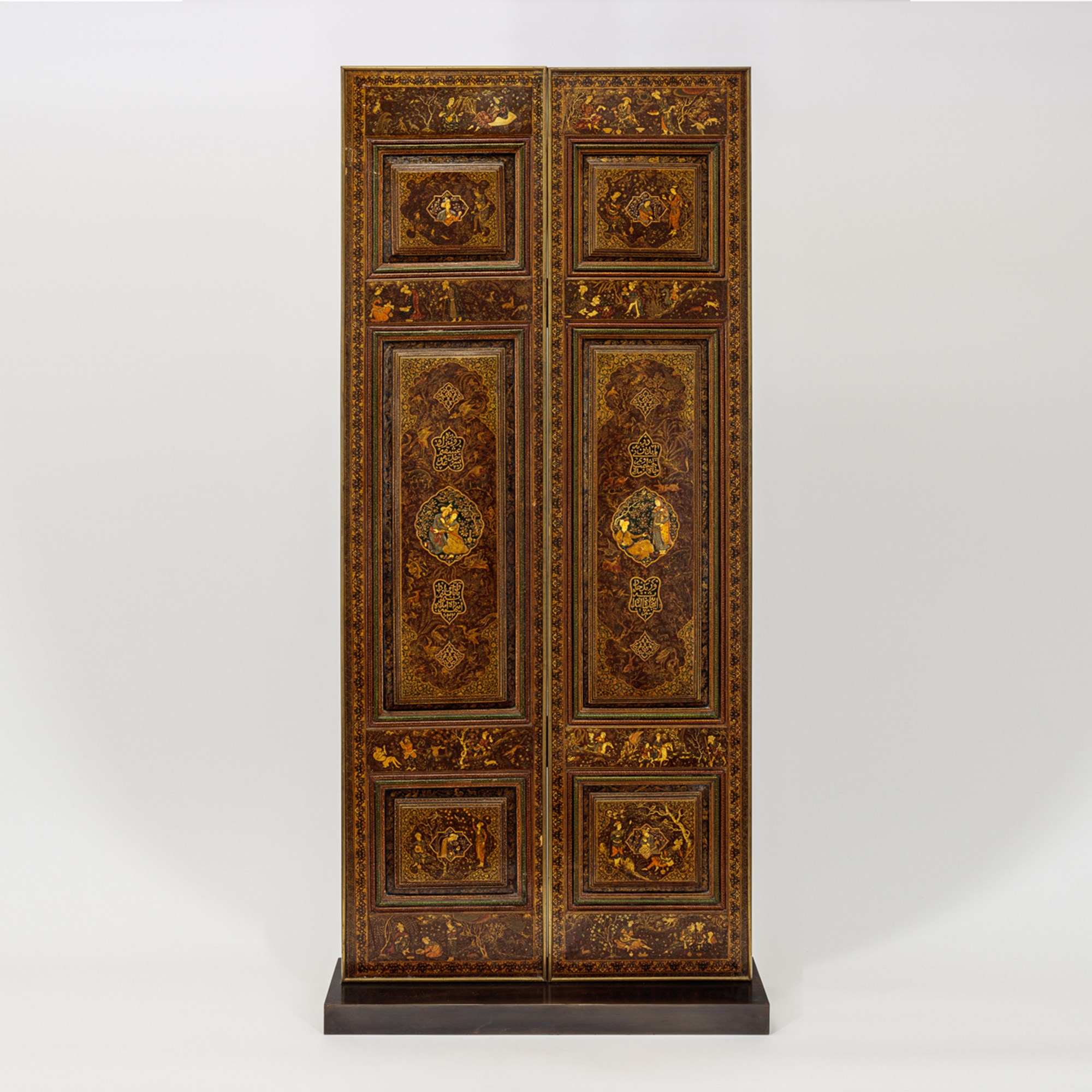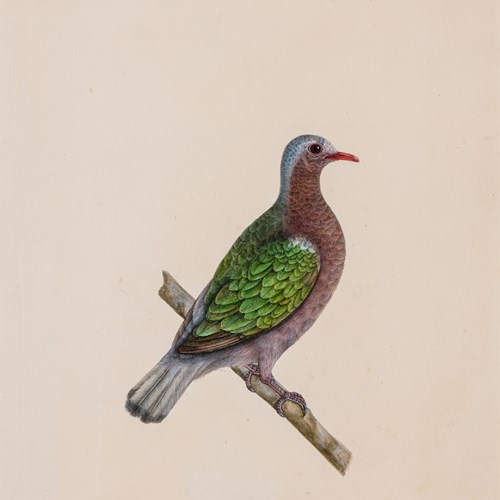Marketplace
A Pair of Qajar Lacquer Doors
A Pair of Qajar Lacquer Doors
Epoque second half of 19th century
Origine Isfahan or Tehran, Qajar Iran
Medium Panelled wooden bases with raised papier-mâché relief
Dimension 36.5 x 162 cm (14³/₈ x 63³/₄ inches)
This pair of finely painted and illuminated lacquer doors, filled with Safavid-revival figures in narrative and at leisure, is a wonderful example of high-quality Qajar craftsmanship. Each door consists of one vertical panel with two horizontal panels above and below, all within a wide frame. The panels all have arabesque corner-pieces, with central figural cartouches decorated in relief. In the vertical panels, there are additional raised pendants above and below the central figural cartouches, filled with inscriptions and split-palmette motifs. Various types of exquisitely painted animals, including lions, bulls, and birds, fill the background of the vertical panels. Figures at leisure in garden landscape occupy background in the horizontal cartouches. The outer frames contain a narrow geometric border, followed by a wider arabesque border. The portion of the frames above and below each panel are narrative compositions, some with figures engaging in a scholarly debate, while others seem more dramatic.
Lacquer doors were produced as early as the end of sixteenth century, during the Safavid period, and continues to be made in the Qajar period, up until the early twentieth century. Finely executed examples such as this would have been used for Safavid and Qajar palaces, as well as the pavilions of members of the upper echelon of the Persian society. With their decorative scheme based on a combination of manuscript paintings, lacquer work, book bindings and even contemporary Persian metalwork, producing these doors would require collaboration between craftsmen from different specialties. For example, the figural and animal depictions on the doors would require painters who are well-versed in seventeenth-century Persian manuscript painting repertoire, while the papier-mâché relief appearance such as that on our example would require assistance from lacquer workers.
Although most of the known surviving doors of this type date to the nineteenth century, where the painting tradition in Iran had shifted dramatically, the style of painting as applied on the doors remained largely the same. This has caused problems for art historians in dating the doors, especially when coupled with the fact that sometimes calligraphers inscribe apocryphal dates on the finished products. Indeed, our example bears an apocryphal date of 1032 AH/ 1622-3 AD at the bottom of one of the cartouches which contains a line of poetry. Two characteristics from our example, however, suggests it was most likely produced between mid-nineteenth century to twentieth century. Firstly, the papier-mâché relief effect, which does not appear on original seventeenth century doors, can be found on a group of lacquer doors including ours, dated to the mid-nineteenth century. Secondly, the most telling evidence for a later example is the size of turbans worn by figures – as a general rule, the later the painting, the bigger the turban.
Nevertheless, the composition of cartouches and depiction of figures on our example strongly recall, in particular, a double frontispiece from the “Vignier Album” dated to ca.1590-1610 in the collection of the Smithsonian Institute (S1986.277, S1986.278). The embracing couple inside the central cartouche, for example, is almost a mirror image of that on the left-hand side of the frontispiece, except the difference in headgear and outfits. The margin paintings on the Vignier frontispiece, depicting figures at leisure but also some fighting scenes, are in similar ideas as the border paintings on the door.
Recently scholars have refocused on the ‘Safavid-revival’ style, recognising the artistic value of lacquer works produced in the Qajar period in their own rights. Eva Baer (1995), for example, recognises the “revivalist tendencies” as a conscious attempt of the Qajars to create a visual bridge between the tradition and their own world.
The inscription in the vertical panels, below the central figural cartouches, is a ghazal by Hāfiz (No.366,Ghazaliyāt):
ما بدين در نه پي حشمت و جاه آمده ايم
وز بد حادثه اينجا به پناه آمده ايم
ره رو منزل عشقیم و ز سرحد عدم
تا به اقلیم وجود این همه راه آمدهایم
We haven't come to this door looking for glory or grandeur
Seeking refuge from bad fortune has brought us here
From nothingness to existence, we have come all this way
As we are travelers of love, and to love we adhere
Comparative material:
A double frontispiece from the Smithsonian Institute (S1986.277, S1986.278)
Reference:
Fehervari, G. ‘A Seventeenth-Century Persian Lacquer Door and Some Problems of Ṣafavid Lacquer-Painted Doors’. Bulletin of the School of Oriental and African Studies 32, no. 2 (1969): 268–80. https://doi.org/10.1017/S0041977X00055300.
Langer, Axel. ‘Chapter 1 Safavid Revival in Persian Miniature Painting: Renewal, Imitation and Source of Inspiration’, 15–27. Leiden, The Netherlands: Brill, 2019. https://doi.org/10.1163/9789004412644_004.
BAER, E. ‘Traditionalism or Forgery: A Note on Persian Lacquer Painting’. Artibus Asiae 55, no. 3/4 (1995): 343–79. https://doi.org/10.2307/3249755.
Stock no.: A5413
Lacquer doors were produced as early as the end of sixteenth century, during the Safavid period, and continues to be made in the Qajar period, up until the early twentieth century. Finely executed examples such as this would have been used for Safavid and Qajar palaces, as well as the pavilions of members of the upper echelon of the Persian society. With their decorative scheme based on a combination of manuscript paintings, lacquer work, book bindings and even contemporary Persian metalwork, producing these doors would require collaboration between craftsmen from different specialties. For example, the figural and animal depictions on the doors would require painters who are well-versed in seventeenth-century Persian manuscript painting repertoire, while the papier-mâché relief appearance such as that on our example would require assistance from lacquer workers.
Although most of the known surviving doors of this type date to the nineteenth century, where the painting tradition in Iran had shifted dramatically, the style of painting as applied on the doors remained largely the same. This has caused problems for art historians in dating the doors, especially when coupled with the fact that sometimes calligraphers inscribe apocryphal dates on the finished products. Indeed, our example bears an apocryphal date of 1032 AH/ 1622-3 AD at the bottom of one of the cartouches which contains a line of poetry. Two characteristics from our example, however, suggests it was most likely produced between mid-nineteenth century to twentieth century. Firstly, the papier-mâché relief effect, which does not appear on original seventeenth century doors, can be found on a group of lacquer doors including ours, dated to the mid-nineteenth century. Secondly, the most telling evidence for a later example is the size of turbans worn by figures – as a general rule, the later the painting, the bigger the turban.
Nevertheless, the composition of cartouches and depiction of figures on our example strongly recall, in particular, a double frontispiece from the “Vignier Album” dated to ca.1590-1610 in the collection of the Smithsonian Institute (S1986.277, S1986.278). The embracing couple inside the central cartouche, for example, is almost a mirror image of that on the left-hand side of the frontispiece, except the difference in headgear and outfits. The margin paintings on the Vignier frontispiece, depicting figures at leisure but also some fighting scenes, are in similar ideas as the border paintings on the door.
Recently scholars have refocused on the ‘Safavid-revival’ style, recognising the artistic value of lacquer works produced in the Qajar period in their own rights. Eva Baer (1995), for example, recognises the “revivalist tendencies” as a conscious attempt of the Qajars to create a visual bridge between the tradition and their own world.
The inscription in the vertical panels, below the central figural cartouches, is a ghazal by Hāfiz (No.366,Ghazaliyāt):
ما بدين در نه پي حشمت و جاه آمده ايم
وز بد حادثه اينجا به پناه آمده ايم
ره رو منزل عشقیم و ز سرحد عدم
تا به اقلیم وجود این همه راه آمدهایم
We haven't come to this door looking for glory or grandeur
Seeking refuge from bad fortune has brought us here
From nothingness to existence, we have come all this way
As we are travelers of love, and to love we adhere
Comparative material:
A double frontispiece from the Smithsonian Institute (S1986.277, S1986.278)
Reference:
Fehervari, G. ‘A Seventeenth-Century Persian Lacquer Door and Some Problems of Ṣafavid Lacquer-Painted Doors’. Bulletin of the School of Oriental and African Studies 32, no. 2 (1969): 268–80. https://doi.org/10.1017/S0041977X00055300.
Langer, Axel. ‘Chapter 1 Safavid Revival in Persian Miniature Painting: Renewal, Imitation and Source of Inspiration’, 15–27. Leiden, The Netherlands: Brill, 2019. https://doi.org/10.1163/9789004412644_004.
BAER, E. ‘Traditionalism or Forgery: A Note on Persian Lacquer Painting’. Artibus Asiae 55, no. 3/4 (1995): 343–79. https://doi.org/10.2307/3249755.
Stock no.: A5413
Epoque: second half of 19th century
Origine: Isfahan or Tehran, Qajar Iran
Medium: Panelled wooden bases with raised papier-mâché relief
Dimension: 36.5 x 162 cm (14³/₈ x 63³/₄ inches)
Provenance: Provenance: French private collection
Plus d'œuvres d'art de la Galerie









_T638815391591372611.jpg?width=500&height=500&mode=pad&scale=both&qlt=90&format=jpg)